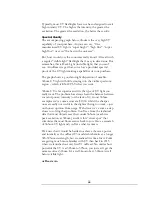
16
Typically, most UV flashlights have not been designed to emit
high intensity UV. The higher the intensity, the greater the
excitation. The greater the excitation, the better the results.
Spectral Quality
The accompanying graph below, illustrate the very high UV
capability of your purchase. Anyone can say, “Our
manufactured UV light is “super bright”, “high flux”, “super
high flux”, or even “the best in the universe”.
But, how would you, the consumer really know? After all with
a regular “visible light” flashlight that’s easy to determine. But
remember, this is Dark Light (invisible light) that you can’t
see. At uvBeast we get that, so we have provided spectral
proof of the UV light emitting capabilities of your purchase.
The graph shows a good and tight dispersion of useable
365nm UV light with little straying into the visible spectrum
region – which is EXACTLY what you want.
365nm UV is far superior and it is the type of UV light you
really want. The problem has always been the balance between
cost and power/intensity (or the lack of it). Good 365nm
examples we’ve come across are $100+ whilst the cheaper
ones are sadly not useful in the slightest being too weak – just
our honest opinion from usage. We believe we’ve come a step
closer to solving that problem. You’ll see from the technical
data that most objects react best under 365nm (or achieve
peak excitation at 365nm), and it is this “sweet spot” that
stimulates the most fluorescence back to you. Have a research
of 365nm UV light and you’ll see what we mean.
We knew that it would be harder to achieve the same power
and intensity as the uvBeast V3 model which emits at a longer
385-395nm wavelength, but we realized it is time for it. Folks
are getting much more familiar with UV than back in 2015
when we launched our very first V1 uvBeast. No matter how
powerful the UV is at 385nm to 395nm, you just can’t get the
same results as 365nm. It’s a well-known fact. 365nm is well
below visible light.
uvBeast.com



































